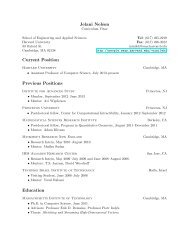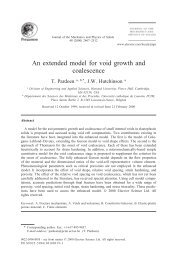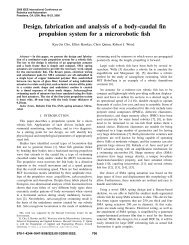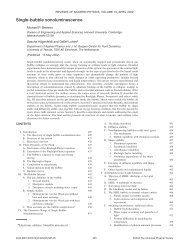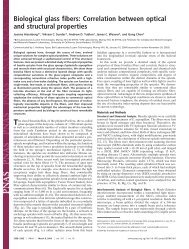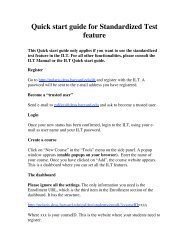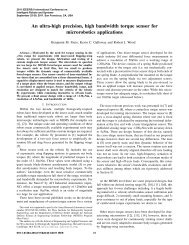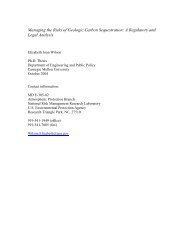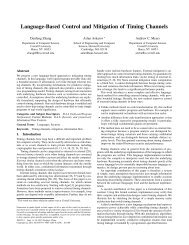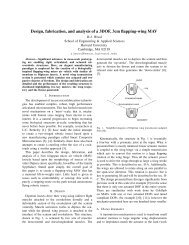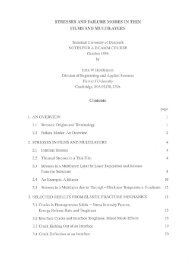CMOS RF Biosensor Utilizing Nuclear Magnetic Resonance
CMOS RF Biosensor Utilizing Nuclear Magnetic Resonance
CMOS RF Biosensor Utilizing Nuclear Magnetic Resonance
Create successful ePaper yourself
Turn your PDF publications into a flip-book with our unique Google optimized e-Paper software.
1642 IEEE JOURNAL OF SOLID-STATE CIRCUITS, VOL. 44, NO. 5, MAY 2009<br />
[5] I. Koh, R. Hong, R. Weissleder, and L. Josephson, “Sensitive NMR<br />
sensors detect antibodies to infuenza,” Angew. Chem. Int. Ed. Engl.,<br />
vol. 47, no. 22, pp. 4119–4121, 2008.<br />
[6] D. Canet, <strong>Nuclear</strong> <strong>Magnetic</strong> <strong>Resonance</strong>: Concepts and Methods.<br />
New York: Wiley, 1996.<br />
[7] Y. Liu, N. Sun, H. Lee, R. Weissleder, and D. Ham, “<strong>CMOS</strong> mini nuclear<br />
magnetic resonance system and its application for biomolecular<br />
sensing,” in IEEE Int. Solid-State Circuits Conf. Dig. Tech. Papers, Feb.<br />
2008, pp. 140–141.<br />
[8] H. Lee, Y. Liu, R. M. Westervelt, and D. Ham, “IC/microfluidic hybrid<br />
system for magnetic manipulation of biological cells,” IEEE J. Solid-<br />
State Circuits, vol. 41, no. 6, pp. 1471–1480, Jun. 2006.<br />
[9] T. Cherifi et al., “A <strong>CMOS</strong> microcoil-associated preamplifier for<br />
NMR spectroscopy,” IEEE Trans. Circuits Syst. I, vol. 52, no. 12, pp.<br />
2576–2583, Dec. 2005.<br />
[10] R. Meller and D. Hartill, “Pulsed NMR magnetometers for CESR,” in<br />
Proc. Particle Accelerator Conf., 2003, pp. 2339–2341.<br />
[11] “Signal/noise ratio optimization tuning system,” U.S. patent 5,347,222,<br />
Sep. 13, 1994.<br />
[12] D. M. Binkley, J. M. Rochelle, B. K. Swann, L. G. Clonts, and R. N.<br />
Goble, “A micropower <strong>CMOS</strong> direct-conversion, VLF receiver chip<br />
for magnetic-field wireless applications,” IEEE J. Solid-State Circuits,<br />
vol. 33, no. 3, pp. 344–358, Mar. 1998.<br />
[13] T. H. Lee, The Design of <strong>CMOS</strong> Radio-Frequency Integrated Circuits.<br />
Cambridge, MA: Cambridge Univ. Press, 1998.<br />
[14] D. K. Shaeffer and T. H. Lee, “A 1.5-V, 1.5-GHz <strong>CMOS</strong> low noise<br />
amplifier,” IEEE J. Solid-State Circuits, vol. 32, no. 5, pp. 745–759,<br />
May 1997.<br />
[15] H. Darabi and A. A. Abidi, “Noise in <strong>RF</strong>-<strong>CMOS</strong> mixers: A simple<br />
physical model,” IEEE J. Solid-State Circuits, vol. 35, no. 1, pp. 15–25,<br />
Jan. 2000.<br />
[16] A. Roch, R. N. Muller, and P. Gillis, “Theory of proton relaxation induced<br />
by superparamagnetic particles,” J. Chem. Phys., vol. 110, no.<br />
11, pp. 5403–5411, Mar. 1999.<br />
[17] G. Eidmann, R. Savelsberg, P. Blümler, and B. Blümich, “The NMR<br />
mouse, a mobile universal surface explorer,” J. Magn. <strong>Resonance</strong>, ser.<br />
Series A, vol. 122, pp. 104–109, 1996.<br />
[18] G. Boero et al., “Fully integrated probe for proton nuclear magnetic resonance<br />
magnetometry,” Rev. Sci. Instruments, vol. 72, pp. 2764–2768,<br />
Jun. 2001.<br />
[19] L. Fan et al., “Miniaturization of magnetic resonance microsystem<br />
components for 3-D cell imaging,” in IEEE ISSCC Dig. Tech. Papers,<br />
Feb. 2007, pp. 166–167.<br />
[20] R. Magin et al., “Miniature magnetic resonance machines,” IEEE Spectrum,<br />
p. 51, Oct. 1997.<br />
Yong Liu (S’03–M’07) received the B.S. and M.S.<br />
degrees from Tsinghua University, Beijing, China, in<br />
2000 and 2003, and the Ph.D. degree from Harvard<br />
University, Cambridge, MA, in 2007, all in electrical<br />
engineering. He is currently with the IBM T. J.<br />
Watson Research Center, Yorktown Heights, NY.<br />
His Ph.D. work examined applications of <strong>CMOS</strong><br />
ICs in medicine and biotechnology, by directly<br />
interfacing <strong>CMOS</strong> ICs with biological systems.<br />
Specifically, his work consisted of two projects.<br />
First, he developed <strong>CMOS</strong> ICs in conjunction with<br />
microfluidic systems to magnetically manipulate individual biological cells for<br />
cell sorting applications. Second, he developed a <strong>CMOS</strong> <strong>RF</strong> biosensor utilizing<br />
NMR for medical diagnostics in a portable platform. Additionally, he worked<br />
on <strong>RF</strong> and mixed-signal ICs for communication and computation systems<br />
during his stay at Harvard, including autonomic PLLs for multi-domain<br />
synchronous clocking. His current research at IBM is on wireline transceiver<br />
design. He has 14 publications, two U.S. patents, and three provisional patents<br />
filed.<br />
In 2001, he was with Tsinghua Tongfang Microelectronics Co., working on<br />
the second-generation Chinese <strong>RF</strong> ID card. In 2005 and 2006, he was with the<br />
Mixed-signal Communications IC Group at IBM T. J. Watson Research Center<br />
as a summer intern. He was the recipient of the Seagate Scholarship, Motorola<br />
Scholarship, Second Prize in the China National Graduate EDA Competition,<br />
and Analog Devices Outstanding Student Designer Award. He is a co-winner of<br />
the Beatrice Editorial Excellence Award in the 2009 IEEE International Solid-<br />
State Circuits Conference (ISSCC).<br />
Hakho Lee (M’05) is an Instructor in Biomedical<br />
Engineering program at the Center for Systems Biology<br />
at the Massachusetts General Hospital (MGH)<br />
and Harvard Medical School (HMS). He received the<br />
Ph.D. degree in physics from Harvard University in<br />
2005, and joined the Center for Molecular Imaging<br />
Research at MGH/HMS as a Research Associate. He<br />
has contributed to developing a new type of micrototal-analysis-systems<br />
by combining integrated circuits<br />
and microfluidics and developed the miniature<br />
NMR system. Dr. Lee’s research topics include the<br />
synthesis of novel magnetic particles and the development of microelectronic<br />
systems for medical diagnosis.<br />
Nan Sun (S’06) received the B.S. degree in<br />
electrical engineering from Tsinghua University,<br />
Beijing, China, in 2006, where he ranked the top<br />
first out of 160 students in the Electrical Engineering<br />
Department every single year, and graduated with<br />
the highest honor and outstanding undergraduate<br />
thesis award. He is currently working towards the<br />
Ph.D. degree in electrical engineering at Harvard<br />
University, Cambridge, MA.<br />
His Ph.D. research is twofold. First, he has<br />
developed several <strong>CMOS</strong> <strong>RF</strong> biomolecular sensors<br />
utilizing nuclear magnetic resonance (NMR) to pursue early disease detection<br />
and low-cost medicine. These systems can be used not only for low-cost<br />
medical diagnostics, but also for oil detection and quantum computing on<br />
silicon. Second, he is developing digital background calibration techniques<br />
for pipelined analog-to-digital converters. In addition to these two works, he<br />
has also made a key contribution to proving the chaotic nature of uncontrolled<br />
soliton oscillators by performing a Lyapunov analysis.<br />
Mr. Sun received the first-class Tsinghua University Outstanding Student<br />
Award in each year from 2003 to 2006. He won the Top Prize in the Intercollegiate<br />
Physics Competition in 2003. He is the recipient of the Samsung Outstanding<br />
Student Award in 2003, Hewlett Packard Outstanding Student Award<br />
in 2006, and Analog Device Outstanding Student Designer Award in 2007. He<br />
won the Harvard Teaching Fellow Award in 2008. He has filed 4 US provisional<br />
patents.<br />
Ralph Weissleder is a Professor at Harvard Medical<br />
School, Director of the Center for Systems Biology<br />
at Massachusetts General Hospital (MGH), Director<br />
of the Center for Molecular Imaging Research,<br />
and Attending Clinician at MGH. Dr. Weissleder is<br />
also a member of the Dana Farber Harvard Cancer<br />
Center, an Associate Member of the Broad Institute<br />
(Chemical Biology Program), and a member of the<br />
Harvard Stem Cell Institute (HSCI). Dr. Weissleder’s<br />
research interests include the development of novel<br />
molecular imaging techniques, tools for detection of<br />
early disease detection and development of nanomaterials for sensing and systems<br />
analysis. His research has been translational and several of his developments<br />
have led to advanced clinical trials with anticipated major impacts when<br />
these methods become routinely available. He has published over 500 original<br />
publications in peer reviewed journals and has authored several textbooks. His<br />
work has been honored with numerous awards including the J. Taylor International<br />
Prize in Medicine, the Millennium Pharmaceuticals Innovator Award, the<br />
AUR Memorial Award, the ARRS President’s Award, the Society for Molecular<br />
Imaging Lifetime Achievement Award, the Academy of Molecular Imaging<br />
2006 Distinguished Basic Scientist Award, and the 2008 RSNA Outstanding Researcher<br />
Award.



